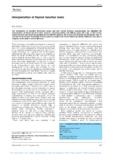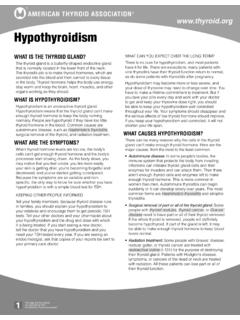Transcription of ANAESTHESIA FOR THYROID SURGERY …
1 Sign up to receive ATOTW weekly - email ANAESTHESIA FOR THYROID SURGERY . ANAESTHESIA TUTORIAL OF THE WEEK 162. 30TH NOVEMBER 2009. Lucy Adams, Specialty Registrar Sarah Davies, Locum Consultant Department of ANAESTHESIA , Leeds General Infirmary, Leeds, UK. Correspondence to QUESTIONS. Before reading the tutorial try answering the following questions. Answers can be found at the end of the text. 1. Hyperthyroidism a. Can be identified by high levels T3/T4 and THYROID Stimulating Hormone (TSH). b. Is most commonly caused by Graves disease c. Patients are prone to exaggerated hypotensive response during induction of ANAESTHESIA d. Increases Minimum Alveolar Concentration (MAC) values e. THYROID SURGERY is usually first line treatment 2. Regarding superficial cervical plexus block a.
2 C1-5 anterior primary rami form the cervical plexus b. Block can be achieved with infiltration along the posterior border of Sternocleidomastoid c. Phrenic nerve palsy is a common complication d. Could be used as a sole anaesthetic technique in a patient with a retrosternal goitre e. Can reduce postoperative morphine requirements. 3. Hypocalcaemia a. Should be diagnosed by total body calcium levels b. Can cause paraesthesiae c. Is indicated by Trousseau's sign d. Can potentiate the negative inotropic effects of volatile anaesthetics e. Reliably prolongs non-depolarising neuromuscular blocking agents INTRODUCTION. THYROID SURGERY can range from simple removal of a THYROID nodule to highly complex SURGERY . The presence of longstanding or large goitres can pose difficult airway management decisions whilst endocrine imbalance can have can have profound systemic manifestations that need to be considered and controlled perioperatively.
3 This tutorial presents some of the more common THYROID pathologies that may be encountered, reviews the anaesthetic management of THYROID SURGERY plus looks at some of the common postoperative complications. ATOTW 162 ANAESTHESIA for THYROID SURGERY , date 30/11/2009 Page 1 of 9. Sign up to receive ATOTW weekly - email THYROID PATHOLOGY AND INDICATIONS FOR SURGERY . There are many indications for THYROID SURGERY , including: THYROID malignancy, goitres that produce obstructive symptoms and/or are retrosternal; hyperthyroidism resistant to medical management;. cosmetic and anxiety related reasons. Patients with hypothyroidism usually respond to thyroxine therapy and SURGERY is rarely indicated. Hyperthyroidism Hyperthyroidism results from excess circulating T3 and T4.
4 The vast majority of cases are caused by intrinsic THYROID disease. Indications for SURGERY include: 1. Grave's disease: An autoimmune condition associated with diffuse enlargement and increased vascularity of the gland caused by IgG antibodies mimicking THYROID Stimulating Hormone (TSH). It is the only cause of hyperthyroidism associated with eye signs and pretibial myxoedema. It can be associated with other autoimmune conditions. 2. THYROID secreting adenomas often presenting as a solitary nodule. 3. Toxic Multinodular Goitre. More common in women; a goitre develops one or two nodules with hypersecretory activity. 4. Other causes that may or may not be associated with goitre include: Exogenous iodine, Amiodarone, Post irradiation thyroiditis. In this group, medical management has proved unsatisfactory and radioiodine is not suitable.
5 Hypothyroidism May be from intrinsic THYROID disease or failure of the hypothalamo-pituitary axis. Those associated with goitre include: 1. Hashimoto's thyroiditis. This is the commonest cause of hypothyroidism and although initially may cause gland enlargement will later lead to THYROID atrophy due to autoantibody destruction of the follicles. 2. Iodine deficiency. A lack of iodine leads to THYROID hormone depletion, THYROID Stimulating Hormone (TSH) stimulation and gland hypertrophy. Dietary iodine deficiency can be found in mountainous areas. Malignancy These will most commonly present as THYROID nodules and are usually minimally active hormonally (patient is euthyroid). The most common types are Papillary and Follicular carcinomas arising from the epithelium that confer a good prognosis if confined to the gland.
6 Medullary carcinomas arising from calcitonin producing cells are associated with Multiple Endocrine Neoplasia II (MEN), which may be linked with phaeochromocytoma and primary hyperparathyroidism. Lymphomas cause diffuse swelling of the gland and carry a very poor prognosis. ANAESTHETIC CONSIDERATIONS. It is fundamental to ensure that patients are clinically and chemically euthyroid prior to embarking on elective THYROID SURGERY . Although the majority of cases may be straightforward the possibility of both expected and unexpected challenging airway situations should be anticipated. Preoperative Assessment History This should be focused on establishing if the patient is clinically euthyroid and assessing for airway compromise. The symptoms of hyper and hypothyroidism can occur insidiously and a collateral history from family may be useful.
7 ATOTW 162 ANAESTHESIA for THYROID SURGERY , date 30/11/2009 Page 2 of 9. Sign up to receive ATOTW weekly - email It is important to establish the pathological nature, position and size of the goitre to appreciate the complexity and potential complications that may occur. A large goitre that has been present for some time may be associated with tracheomalacia postoperatively. Symptoms of dysphagia, positional breathlessness with a difficulty lying flat, change in voice or stridor may alert the anaesthetist to possible difficulties with airway compromise on induction. Evidence of other systemic disease, cardiorespiratory compromise and associated endocrine or automimmue disorders should also be sought. For example, medullary THYROID cancer associated with phaeochromocytoma.
8 Examination The patient should be assessed for signs of hyperthyroidism or hypothyroidism (Table 1). An examination of the goitre or nodule should be performed to assess size and extent of the lesion. A. fixed hard nodule suggests malignancy with possible tethering to surrounding structures and limited movement. An inability to feel the bottom of the goitre may indicate retrosternal spread. The trachea should be examined to check for any deviation or compression. Retrosternal or large goitres can compress surrounding structures and may elicit signs of superior vena cava (SVC) obstruction, Horner's Syndrome, pericardial or pleural effusions. A mandatory detailed airway examination would also include assessment of atlantoaxial flexion and extension, thyromental distance, Mallampatti, mandibular protrusion and incisor distance.
9 Table 1. Clinical features Hypothyroidism / Hyperthyroidism HYPERTHYROIDISM HYPOTHYROIDISM. General Weight loss, Malaise, Malaise, Cold intolerance, Muscle weakness, Heat intolerance, Myalgia, Arthralgia, Cachexia, Palmar erythma, Dry, coarse skin. Proximal muscle wasting, Peaches & Cream complexion', Pretibial myxoedema (Graves Loss of eyebrows, Hypothermia, disease) Carpal tunnel syndrome, Myotonia Central nervous Irritability, Anxiety, Poor memory, Depression, Psychosis, system Hyperkinesis, Tremor Mental slowness, Dementia, Poverty of movement, Ataxia, Slow relaxing reflexes Deafness Cardiovascular Palpitations, Angina, Breathlessness, Hypertension, Bradycardia, Hypertension, Cardiac failure, Heart failure, Oedema Tachycardia, Tachyarrhythmias, Pericardial & pleural effusions, Atrial fibrillation, Vasodilatation Anaemia, Cool peripheries Gastrointestinal Increased appetite, Constipation, Vomiting, Diarrhoea Obesity Genitourinary Oligomenorrhoea, Menorrhagia, Loss of libido Loss of libido Eye (Graves Blurred / double vision, disease only)
10 Exophthalmos, Lid lag, Conjunctival oedema ATOTW 162 ANAESTHESIA for THYROID SURGERY , date 30/11/2009 Page 3 of 9. Sign up to receive ATOTW weekly - email Investigations 1. Routine blood tests include Full Blood Count (FBC), electrolytes, THYROID function and corrected calcium levels. It is imperative to ensure the patient is euthyroid prior to SURGERY to avoid complications of a THYROID storm or myxoedema coma in the perioperative period. FBC is essential due to the potential for blood loss during the procedure plus to detect any serious adverse haematological effects of concurrent antithyroid medications. (Table 2). 2. A CXR may be useful to assess the size of goitre and detect any tracheal compression or deviation. Lateral thoracic inlet views may also help to assess retrosternal extension and the tracheal anteroposterior diameter.















